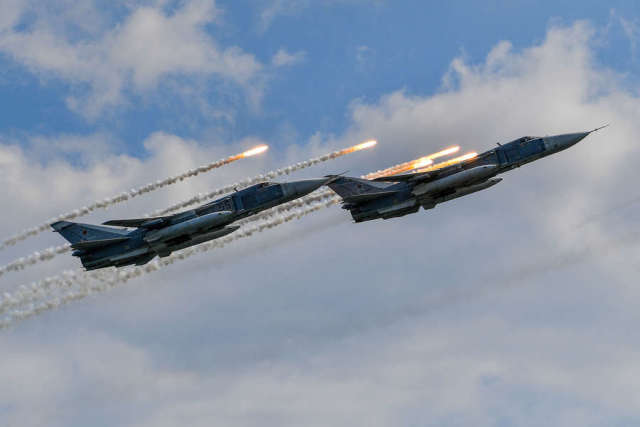Air Force General Popov spoke about the tactics of the Su-24M at extremely low altitudes
For the first time, the Russian Defense Ministry has published a video showing a Su-24M front-line bomber striking the positions of the AFU at extremely low altitude. "Newspaper.Ru" figured out in which cases this tactic is used and how the aircraft gets away from being hit by enemy air defenses.
A video distributed by the military department shows a bomber flying at high speed at the height of trees. Then he drops bombs on parachutes and leaves. After a while, a series of explosions on the ground follows.
"The bombing of the long-term structures of the fortified area was carried out from a free maneuver from an extremely low altitude. Aviation bombs were used for high-explosive action - this made it possible to achieve the greatest efficiency," the Ministry of Defense reported.
The Su-24 is designed for missile and bomb strikes. It is equipped with a terrain envelope system that allows you to fly safely over the terrain in manual or automatic mode, including at supersonic speed.
"Extremely low altitudes at which an aircraft can perform combat missions are considered to be heights from 50 to 300 m. It is necessary to approach the target at safe altitudes and less noticeable course angles for air defense. Then go to a low altitude and use a means of destruction: to carry out missile launches, shooting or bombing. Low altitudes are needed during the so-called "assault" in order to provide a more accurate exit to the target. The effectiveness of such strikes is very high - you can throw a bomb right through the window of a building," he told the newspaper.En" retired Air Force Major General, former head of the Federal Directorate of Aerospace Search and Rescue under the Ministry of Defense Vladimir Popov.
According to him, judging by the published footage of the Ministry of Defense, the Su-24M used assault ammunition of the FAB-250 or FAB-500 type, which are equipped with braking parachutes.
"They are needed so that, firstly, the aircraft can safely escape from the blast wave and fragments of ammunition. At low altitudes, this is very important. For example, there is a bomb FAB-100 - it has a scattering of fragments of 1500 m, but it is not equipped with a parachute, at an altitude below 1500 m it is unsafe to use it. Secondly, if such bombs are used in fortified areas, then a parachute is needed so that the bomb enters the ground as vertically as possible. It even has a special booster engine that turns on right above the target - thanks to it, the rocket breaks through concrete, crashes deep into the ground and explodes there. The Su-24M uses these munitions very effectively, but it is quite difficult to control the aircraft at extremely low altitudes at speeds from 800 to 1200 km/ h. This can be done by a very high-class pilot," Popov said.
According to Konstantin Sivkov, a corresponding member of the Russian Academy of Rocket and Artillery Sciences, flying at extremely low altitudes allows the aircraft to successfully overcome enemy air defenses.
"When flying at such altitudes, the aircraft is below the radar surveillance zone, at this altitude it is detected too late. As a result, the aircraft can strike without being hit by air defense. As for portable anti-aircraft missile systems (MANPADS), when flying at an altitude of about 100 m, the MANPADS operator simply does not have time to bring the complex. Against an aircraft flying at extremely low altitudes, both fire weapons and small arms are ineffective. The only case in which an aircraft can be hit at extremely low altitude is if there is a continuous high-altitude radar field in the area, which can be created by long-range radar detection aircraft," he told the newspaper.En" Sivkov.
According to Popov, there is a risk that an aircraft flying at extremely low altitudes may be shot down by MANPADS, but it is minimal.
"The footage of the Ministry of Defense shows how the plane shoots off heat traps. They are taking away missiles with thermal homing heads. All MANPADS work exactly on this principle - they shoot after an aerial target, that is, by thermal radiation. The aircraft engines are running, the gas exhaust is coming - their temperature reaches 600 degrees, the homing head of the MANPADS rocket notices this.
Popov concluded.
Irina Alshayeva

